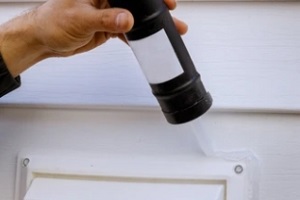 Caulking is a vital part of keeping your home secure against moisture intrusion, pest entry and even high utility bills. However, just because the height of summer heat and frigid winter temperatures are the most likely times when you will notice inadequate exterior caulking (due to drafts) does not mean that this is the right time of year to apply new caulk to fix the problem.
Caulking is a vital part of keeping your home secure against moisture intrusion, pest entry and even high utility bills. However, just because the height of summer heat and frigid winter temperatures are the most likely times when you will notice inadequate exterior caulking (due to drafts) does not mean that this is the right time of year to apply new caulk to fix the problem.
In fact, in order to get the best results, certain times of year and even of the day are better than others for adhesion and long-term quality. You can always trust the experts to give you the best possible results for the circumstances, but if you would like to try applying exterior caulking for yourself, remember the following important facts about how the weather affects your project.
View Commercial Exterior Caulking Services
When The Caulking Temperature Is Right
One of the most important aspects of applying caulk is making sure to do so when the temperature is in the right range. If the caulk gets too cold or too hot, it will not adhere like it is supposed to. This can impact not only how cleanly and thoroughly it clings to a surface but also how well it expands and contracts as temperatures continue to change over a time. If it remains very rigid or poorly adapted due to improper application, it will not shrink and expand appropriately, causing it to pull up from the surface and reveal the crack or joint that you just sealed.
Caulk is best applied when temperatures are a minimum of 45 degrees Fahrenheit (that is about 7 degrees Celsius). Spring and fall are the most likely candidates for achieving this temperature consistently. If you have your choice of days that fulfill this criterion, opt for the day with the smallest difference between the daytime temperature and nighttime temperature. This will prevent the caulk from needing to expand or contract so soon after application while it cures, resulting in a better seal.
Is It Raining, Snowing Or Windy?
Another important factor to keep in mind when applying exterior caulking is what the weather conditions are like. Naturally, snow should be completely avoided, since it is likely already too cold for caulk. However, you should do everything possible not to caulk in the rain either, since the moisture can interfere with a smooth seal. Additionally, moisture (even on sunny days with high humidity) can cause the joints that you are sealing to expand; when the moisture is gone, your new caulk may pull away as the crevice returns to its natural shape.
Stick with a dry, sunny day if you can, and avoid the wind; a breeze can blow dust and debris into your crisp new caulk line, where it will set. Not only can this cause an eyesore, but it may—you guessed it—stop the caulk from adhering properly. Warm, dry and calm is the weather you are looking for.
What To Do If Caulking Must Be Done In Winter
 No matter how prepared you may be, your home may suddenly find itself in need of repair in the dead of winter. If you are experiencing a caulking emergency that simply cannot wait until warmer weather, it is possible to apply caulk in the winter. While this is not ideal, there are things that you can do to improve the outcome. Wait until the warmest part of the day, and ensure that any surfaces you are working with are dry and free of ice.
No matter how prepared you may be, your home may suddenly find itself in need of repair in the dead of winter. If you are experiencing a caulking emergency that simply cannot wait until warmer weather, it is possible to apply caulk in the winter. While this is not ideal, there are things that you can do to improve the outcome. Wait until the warmest part of the day, and ensure that any surfaces you are working with are dry and free of ice.
The day before you intend to caulk, be sure to leave the caulking tube in your home or in an area that exceeds 60 degrees for at least one day before your project. You may find it helpful to bring a jar of warm water outside with you during caulking to rewarm the tube when the caulk becomes more firm due to the cold. The pros can help you to apply caulk in challenging places or at less ideal times of the year.
Trust The Experts To Finish Your Caulking Project The Right Way The First Time
If you are considering an exterior caulk project and would like to ensure that you get the best results possible, the right way to approach the problem is to trust the experts. Waterproof Caulking & Restoration has years of experience applying caulk and can work with you to find the perfect time to tackle the project for the best long-term results. Reach out to discuss your goals for your exterior caulking as well as any questions or concerns that you may have so that you can seal your home the right way for years to come.
